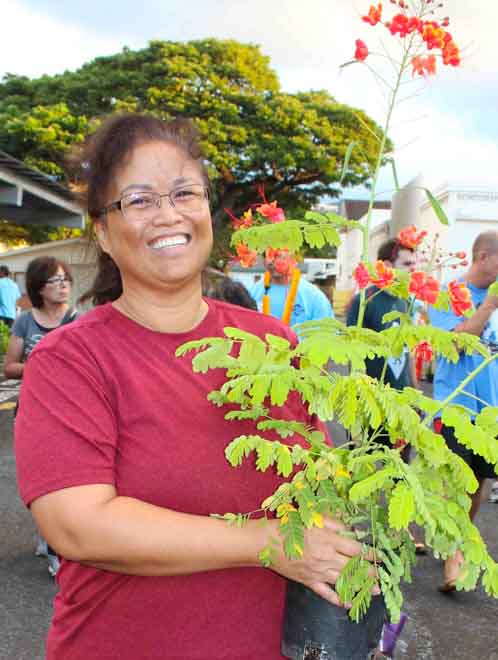 Mulch
Mulch
After proper selection and planting, the single best thing you can do for any tree, just planted or older, is to mulch. Organic mulch can be purchased at most garden supply stores or from mulch suppliers. You can also create mulch from your own compost pile.
Mulch retains moisture, protects trees from damage from lawn mowers and weeders, moderates soil temperatures, provides a natural interchange of nutrients, controls weeds, and eliminates competition for space, nutrients, and moisture from grass. Mulch zones should encircle the tree from the trunk to a distance of at least three feet.
Larger trees should be mulched from the trunk to a distance of approximately one foot for each inch of trunk diameter. If it is impractical to mulch the prescribed distance for larger trees, the mulch zone should be as large as possible, but at least twelve feet in radius from the trunk.
Water
Water management is based on the size and type of plant, air temperature, humidity, amount of sunlight, wind, and soil type. The most important criteria is to select a tree that is appropriate and tolerant of the natural water levels of your neighborhood. However, during dry or hot and windy periods, especially with very light and sandy or heavy clay soils, additional watering is desirable.
When watering is performed, it should be done in the early morning. This will minimize water loss from evaporation and will allow time for leaves and soil to dry, which helps prevent fungal problems. Watering should be performed infrequently and slowly so that it percolates deeply into the soil. This encourages good root structure and better root distribution. Water should be distributed evenly to as much of the root system as possible.
Fertilizer
Like watering, fertilizing should be kept to a minimum. A regular mulching program should maintain a good nutrient cycle, minimizing the need for supplemental fertilizer. However, on certain sites where certain nutrient requirements cannot be maintained or acquired, or construction or damage creates stress, fertilizer is beneficial.
It is advisable to consult a Certified Arborist for fertilization recommendations for specific tree species and conditions. Generally, a slow-release fertilizer, applied at rates according to label directions during times when moisture levels are high, is the most effective.
Pruning
 Pruning should be performed to remove dead, damaged, diseased, and crossing limbs, to reduce crowding of branches, and to eliminate hazards. Pruning can also be performed to slow growth, to reduce wind resistance, to increase light penetration, to shape the canopy and to prevent or enhance flowering and fruiting. Consult a landscape professional regarding pruning, especially if the tree is near power lines.
Pruning should be performed to remove dead, damaged, diseased, and crossing limbs, to reduce crowding of branches, and to eliminate hazards. Pruning can also be performed to slow growth, to reduce wind resistance, to increase light penetration, to shape the canopy and to prevent or enhance flowering and fruiting. Consult a landscape professional regarding pruning, especially if the tree is near power lines.
The key to pruning is to select the correct limbs for removal and to make the proper pruning cut, called “natural target pruning.”
Always cut at nodes. Nodes are where branches meet other branches or the main trunk.
 Do not remove more than one-third of the foliage at any single pruning.
Do not remove more than one-third of the foliage at any single pruning.
Always make proper cuts. Proper pruning cuts use the branch bark ridge as a guide. Start the cut next to the top and beside the branch bark ridge. Do not cut the ridge. The final cut should be at an opposite and approximately equal angle to the bark branch ridge. This will remove the target limb without damaging the branch collar, which will enable the tree to effectively compartmentalize the wound and protect itself from rot and disease.
Do not paint cuts. Wound dressings do not help the tree and can actually cause harm by inhibiting wound closure and providing a warm, moist site for decay-causing organisms such as fungi.